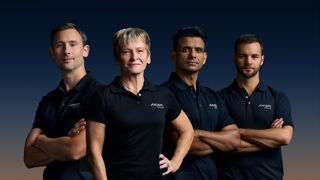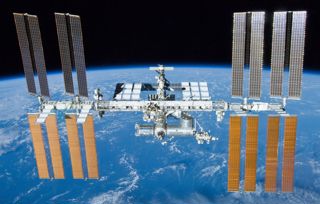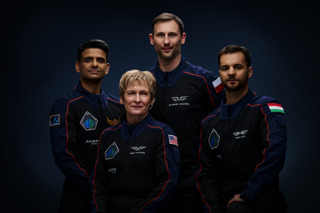
What's Happening in Space: June 2025
- 27th May 2025
- Author: Dhara Patel
A summary of space events through the month
The National Space Centre's Space Expert Dhara Patel joins us with her regular overview of some notable space and science events coming up in the weeks ahead...
28th May – Starship flight 9
Starship is made up of the Super Heavy booster – a first stage rocket with 33 of SpaceX’s raptor engines, and on top of that sits the upper stage - rather confusingly also called Starship (which hosts 6 engines). And when its fully developed, this launch vehicle will be a completely reusable rocket – both first and second stages. A modified version of Starship is also currently planned to land astronauts on the Moon with the Artemis 3 mission. Starship is due to launch on its ninth test flight shortly after midnight (00:30) on 28 May from SpaceX’s launch facility, Starbase in Boca Chica, Texas, United States. Similarly to Flight 7 and 8, the mission will test a new, upgraded version of the upper stage of the rocket – the Block 2 Starship vehicle (with the current Block 1 Super Heavy booster vehicle underneath). During the seventh flight the first stage separated normally, and the booster was caught by the launch tower, "Mechazilla", for the second time in three missions. But the upper stage was lost about six minutes after liftoff and exploded over the Atlantic - likely caused by a fuel leak. Similarly flight 8 ended in a RUD (rapid unscheduled disassembly) after the vehicle lost control and began to tumble - a failure which occurred shortly after launch. Test flight 9 hope to improve on the outcomes of the previous flights. Find out more about Starship and SpaceX’s other rocketry achievements in our SpaceX – the world’s rocket giant blog by Ed Kellond-Turner in our Education team.
28th May – Tianwen 2 mission launch
Targeting a launch at 18:30 on 28 May on a Long March 3 rocket from the Xichang Satellite Launch Center in China, is the Tianwen 2 mission. Developed by the China Aerospace Science and Technology Corporation (CASC), this mission is set to return samples from near-Earth asteroid 469219 Kamo’oalewa. The asteroid shares a similar orbit to Earth around the Sun and appears to orbit Earth. It is a small, near-Earth asteroid, likely a fragment blasted from the Moon's Giordano Bruno crater. The mission aims to collect about 1kg of samples from its surface using both touch-and-go and anchor-and-drill approaches. After delivering the samples back to Earth (around 2.5 years after launch), the main spacecraft will continue its mission by rerouting to comet 311P/PANSTARRS, arriving around seven years later. Tianwen 2 represents China's first asteroid sample return mission and its first dual-target mission exploring both an asteroid and a comet.

Throughout June – spot the International Space Station
There may be opportunities throughout June to spot the International Space Station (ISS) moving across the sky – use NASA’s Spot the Station to find out when and where to spot the largest artificial satellite overhead. It’ll look like a bright star moving relatively quickly across the sky (generally from west to east) and will be visible to the naked eye.
Throughout June – Stargazing challenges / National Space Centre - Space NOW! podcast
Each month, the National Space Centre will be sharing a trio of stargazing challenges for everyone to have a go at. From spotting the Moon and familiar star patterns, to catching meteor showers and some deep sky objects. Check out the Stargazing Challenges - June 2025 blog for more details.
And they’ll be going beyond the headlines unpacking some of the current space news stories in our podcast, so tune into Space NOW! to listen to new and previous episodes!
1st June / 29th June – Moon and Mars close in the sky
Look for Mars positioned beside the Moon during the evening of 1st June in the western sky. The waxing crescent moon will have been in conjunction (sharing the same right ascension – coordinate) with Mars earlier that morning but won’t be visible - they should be seen in close proximity in the evening from around sunset as the sky begins to darken, up until just after midnight when they’ll set. The best time to view them will be when they’re closest together and high in the sky – so try and spot them during the late evening in the hours before midnight. They will be visible to the naked eye. Mars will appear as a red point of light sitting to the right of the Moon, and you may also spot a bright white-ish point lying to the left of the Moon – that is the brightest star in the constellation of Leo, called Regulus. At the end of the month, on 29 June, you’ll see the trio together again in the evening western sky. But on this occasion, the waxing crescent moon will appear with Mars to its left and Regulus on its right. Find out more about close approaches and conjunctions in our astronomical phenomena blog written by David Southworth in the NSC Education Team.
5th June – Hakuto R-2 landing on the Moon
HAKUTO-R is a commercial lunar exploration program operated by the private Japanese company ispace and currently includes their first two lunar missions. The first mission attempted a landing in April 2023 but unfortunately communication with the lander was lost during the final seconds of its descent. This second mission which launched on 15 January 2025 (and took a longer trajectory / path to the Moon to save energy) is due to soft land on the Moon with its Resilience lander at 20:24 on 5 June, and then deploy a micro rover also manufactured by the company. This rover is expected to collect lunar regolith as part of a contract with NASA signed in 2020 in which companies will collect materials on the Moon and then transfer ownership "in situ" to the agency to help support the Artemis program. It's a technology demonstration mission with the goal of establishing reliable transportation and data services on the Moon in the future.

8th June – Axiom Mission 4 (Ax-4) launch
Delayed from late May, the Axiom Mission 4 will now target the launch a Crew Dragon spacecraft to the International Space Station onboard a SpaceX Falcon 9 rocket at 14:11 on 8 June from Kennedy Space Center, Florida. The commercial mission will include former NASA astronaut Peggy Whitson as commander, Shubhanshu Shukla of India, Sławosz Uznański of Poland, and Tibor Kapu of Hungary. This will be India and Poland's first crewed trip to the ISS and Shubhanshu Shukla is one of the astronauts already chosen for India’s first crewed Gaganyaan mission in 2026 – the nation’s first human spaceflight programme. The Axiom-4 mission is planned to last around two weeks and the astronauts on board will carry our science, outreach, and commercial activities. Find out more about the private space company Axiom Space in this blog by Harsh Patel formerly in the NSC Space Comms team.
11th June – full moon (08:43)
Known as the Strawberry moon (according to the old Farmers’ Almanac), this full moon is named to mark the time of year when it was favourable to start harvesting strawberries. Check out the Full Moon: Full Facts blog written by Mike Darch in our Education team to find out more.
18th June – NISAR mission launch
The NISAR satellite, NASA-ISRO Synthetic Aperture Radar, is a joint mission by the American and Indian space agencies. It is scheduled to launch at 12:30 on 18 June on a GSLV Mk II rocket from the Satish Dhawan Space Centre in India. The mission will map the elevation of the Earth’s land and ice masses up to half a dozen times a month, with a resolution of 5-10 metres. It will use radar pulses that are directed at the Earth, reflected off its surface, and then detected by the satellite, to create high resolution images of our planet’s surface. And by doing so, it will help us better understand some of the Earth’s most complex natural processes like ice sheet collapse and natural disasters such as landslides and tsunamis. Find out more about the NISAR satellite in this blog by Ed Kellond-Turner in our Education team.
19th June – Moon and Saturn close in the sky
Look for the waning crescent moon near Saturn during the early morning of 19 June before sunrise in the eastern sky. The Moon will be in conjunction (sharing the same right ascension – coordinate) with Saturn just after sunrise when daylight will drown out the light from the ringed planet, so the best time to spot the duo close together is a short while before that - during the early hours of 19 June around 4:00. Saturn will sit just below the Moon and the pair will be visible to the naked eye, but clear views without tall buildings and trees will help you spot them more easily. Check out the astronomical phenomena blog linked above to find out more about close approaches and conjunctions.

21st June – summer solstice (03:42)
In the Northern Hemisphere, the June solstice (also called the summer solstice) is when the North Pole of the Earth becomes most tilted towards the Sun during its yearly orbit, and as a result the Sun reaches its northernmost position in the sky being directly over the Tropic of Cancer. This marks the beginning of northern hemisphere summer in the astronomical calendar. We experience the year's longest day in terms of daylight. Find out more about Equinoxes and Solstices in this blog by Catherine Muller formerly in the NSC Space Comms team.
22nd June – Moon and Venus close in the sky
Look for the thin waning crescent moon near Venus during the early morning of 22 June before sunrise in the eastern sky. Venus will appear like a bright star and sit below the Moon. The Moon will be in conjunction (sharing the same right ascension – coordinate) with Venus just around 9:30 so Venus will be lost in the daylight at that time. Instead, the best time to spot the pair close together is around 3:30, when they creep higher above the horizon but before the Sun rises and daylight drowns them out. They’ll be visible to the naked eye, but clear views without tall buildings and trees will help you spot them more easily especially as they’ll be low on the horizon. Check out the astronomical phenomena blog linked above to find out more about close approaches and conjunctions.
25th June - new moon (11:31)
The new moon will occur in the constellation of Gemini. The lack of moonlight interference provides a great time to try and view deep sky objects (especially with the aid of binoculars and telescopes). We have a blog on Moon phases written by Mike Darch in the NSC Education team.
Please note: As this summary is created at the end of the month before, dates (especially launch dates) can often change or be updated, so this content may become outdated - we always recommend checking on the relevant organisation's pages.
